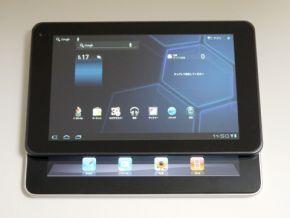Try the tablet terminal "Optimus Pad L-06C" with Android 3.0 (page 1/3)
Similarly, as a tablet with Android 3.0, KDDI released Motorola's "XOOM Wi-Fi" in April the following year. Is there a point or difference? I tried using the product version belatedly, so I would like to send a review.

8.9-inch LCD, multimedia-oriented terminal
What surprised me when I picked up the Optimus Pad was that it had a screen size that I had never seen before. Compared to the 9.7-inch iPad, which can be said to be the representative of tablets, the Optimus Pad is 8.9-inch. Due to the wide ratio, the impression that I actually picked up is one size smaller than the iPad, or even two sizes smaller. The footprint is about 150 x 243 mm, so compared to the original iPad (189.7 x 242.8 mm), it can be said that the width is almost the same and the body is slim.
Comparison with the iPad (right). The width is almost the same (photograph = left) / When stacked with the iPad (bottom) (photograph = right)However, the weight is quite heavy. The Optimus Pad weighs about 620 grams, which is lighter than the original iPad (about 730 grams: Wi-Fi + 3G model) and XOOM Wi-Fi (about 700 grams), but compared to the iPad 2 Wi-Fi + 3G model (613 grams). slightly above. The body is long and thin, so when you hold it in your hand, it feels heavier than it actually is.
Though it's slimmer than the iPad2, it's heavy because of its thickness. The Optimus Pad is about 14.1 mm at its thickest part and 12.8 mm at its thinnest part, which is thick enough to handle compared to the original iPad (13.4 mm), but considerably thicker than the iPad2 (8.8 mm). By the way, it is almost the same thickness as XOOM Wi-Fi, which is the same Android 3.0 tablet.
The width of the bezel is a bit wider than the iPad (right), but it doesn't really matter (photo = left) / The thickness is almost the same as the iPad (right) (photo = right)< p> The hardware specs are the same as XOOM Wi-Fi, with NVIDIA Tegra2 (1GHz) running on dual core CPU and 1GB of RAM. In addition, it has a built-in memory of 32 GB and a microHDMI terminal, which is similar to XOOM Wi-Fi, suggesting that it is based on the same reference.top. Equipped with volume up / down buttons (photo = left) / bottom side. It has a microUSB connector and a microHDMI connector. Not compatible with USB charging (photo = right)Left side. Equipped with a power button, speaker, earphone jack, and power connector (photo = left) / right side. Equipped with two speakers (photo = right)However, differences from XOOM Wi-Fi can be seen everywhere. In an easy-to-understand way, it has a 3G line (XOOM also has a model with a 3G line, but it is not sold in Japan). Another big difference is that it has a dual camera with about 5.1 million pixels on the back, and it can shoot trendy 3D images. In addition, it has a total of three speakers, and it is unique that it can be listened to in stereo either vertically or horizontally, and it can be said that it is a tablet with a strong multimedia orientation.
Back. Almost flat shape except for the camera part. If you remove the cover on the right, you will find a SIM slot and a reset button (photo = left) / 2-megapixel in-camera on the upper left of the front. The LED directly below blinks when an email arrives (photo = center) / Equipped with a dual camera of approximately 5.1 million pixels, capable of 3D shooting (photo = right)In addition, the XOOM Wi- Another difference is that Fi is Bluetooth v2.1, while Optimus Pad is v3.0. On the other hand, the microSD slot installed in XOOM Wi-Fi is not available, but at the time of writing this article, the microSD slot of XOOM Wi-Fi is not yet available, so comparison with XOOM Wi-Fi In that sense, it is difficult to be a decisive factor for evaluation.
What is the difference between Android 2.x series and Android 3.0? 1|2|3Next page notebook-laptop
notebook-laptop






